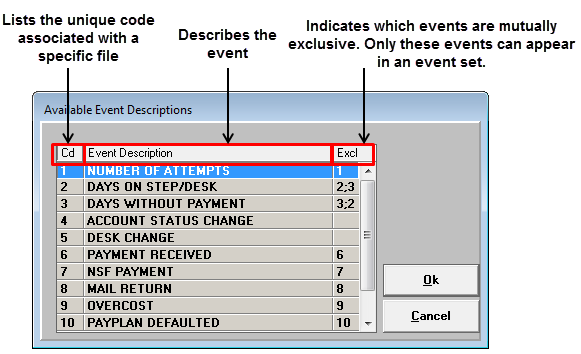Descriptions of available strategy events
The Available Event Descriptions window referenced in Creating or changing strategy events displays the list of available event options for the AFM strategy. In many of the value fields, you can also use wildcards. For more information, see Using wildcard characters in strategies.

Strategy event codes
|
Code |
Event |
Description |
In the Value field |
Exclusions |
|
1 |
Number of Attempts |
Indicates, in the Tickler, the number of days an account has been worked. Only one attempt per day is logged, no matter how many times the collector updates the Tickler for that account. |
Type a number. |
An event set can only have one code 1. |
|
2 |
Days on Step/Desk |
Indicates the number of days the account is on the desk. |
Type a number. |
An event set can only have one code 2 event and cannot be used with code |
|
3 |
Days without Payment |
The number of days without account payment is calculated according to the following rules:
|
Type a number. |
An event set can only have one code 3 event and cannot be used with code |
|
4 |
Account Status Change |
Allows you to monitor the occurrence of one of the valid status codes in the status code field. If the status code changes to the value you specify, further action can be taken based on that event. For example, you might wait for the status to change to "LEG" (Legal) before moving it to the legal desk. |
Type the status code -or- Type ? to select from the list of status codes. |
None |
|
5 |
Desk Change |
Allows you to monitor the occurrence of a desk change in the desk field. The Collector System waits for a user or another system process to change the account to a specified desk. After the account moves to that desk, the system proceeds with further evaluation or action. |
Type ? to select from the list of valid desks. |
None |
|
6 |
Payment Received |
Indicates what action to take if a payment is received on this account. |
The system automatically fills the field with Y. |
An event set can only have one code 6. |
|
7 |
NSF Payment |
Indicates a non-sufficient fund payment. |
The system automatically fills the field with Y. |
An event set can only have one code 7. |
|
8 |
Mail Return |
Indicates a mail return was received. |
The system automatically fills the field with Y. |
An event set can only have one code 8. |
|
9 |
Overcost |
Indicates an overcost situation has occurred. An overcost is an amount determined by your agency to track when an account is no longer profitable. For more information about overcosts, see Menu 10.3.25 - Account Strategy. |
The system automatically fills the field with Y. |
An event set can only have one code 9. |
|
10 |
Payplan Defaulted |
Indicates the payment plan defaulted. The Collector System is designed to cause the payment plan functionality to take precedence over AFM. If an account is on a payment plan, the system ignores any instructions by AFM unless the account defaults on the plan. At this point, if AFM is waiting for the account to default, it takes control of the account. This setting applies if you have payment plans set up to run with AFM. For more information, see Allowing payment plans and post-dated check plans to work with AFM. |
The system automatically fills the field with Y. |
An event set can only have one code 10. |
|
11 |
Value in Data Field |
Allows you to monitor the occurrence of a Fiscal field update. This event allows you to create your own event by telling the system what field you want it to use and what value you want to wait for. |
Type the specific field and value to monitor. |
None |
|
13 |
Days since assignment or payment |
The number of days since account assignment or payment, whichever is most recent. |
Type a number. |
An event set can only have one code 13 event and cannot be used with codes 2, 3, and 14. |
|
14 |
Days on strategy; reset by payment |
The number of days since strategy start date or payment, whichever is the most recent. |
Type a number. |
An event set can only have one code 14 event and cannot be used with codes 2, 3, and 13. |